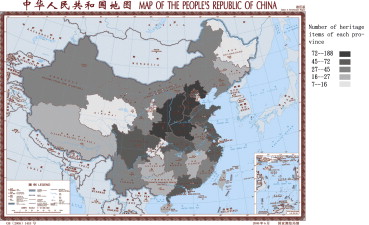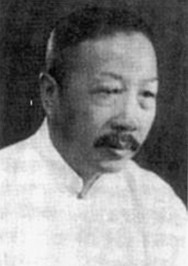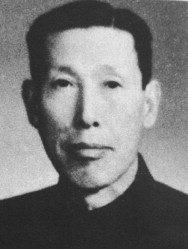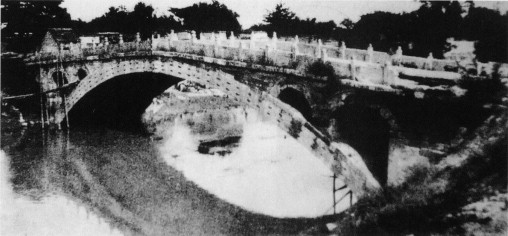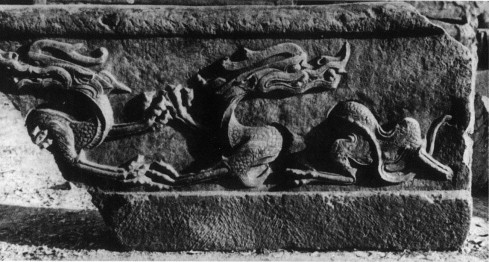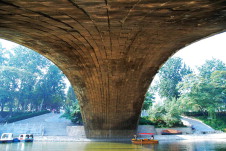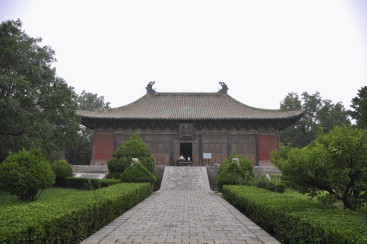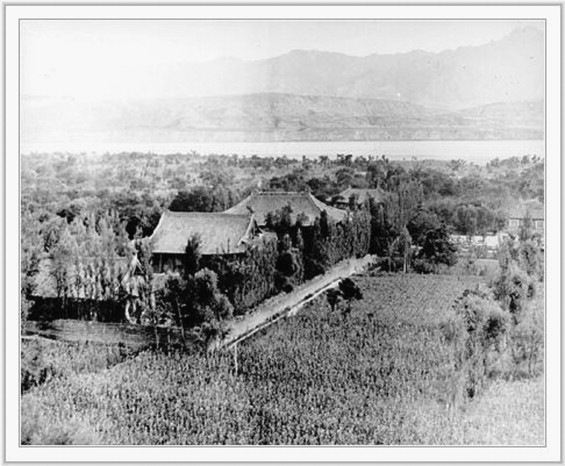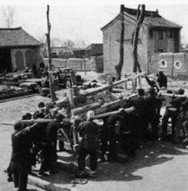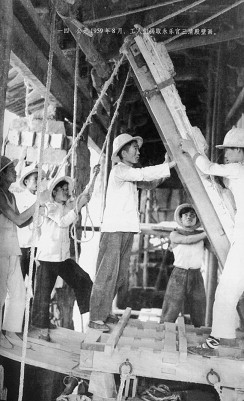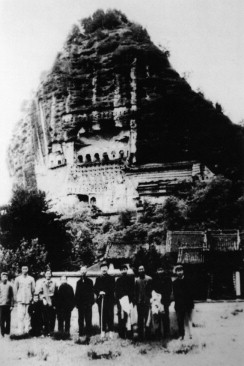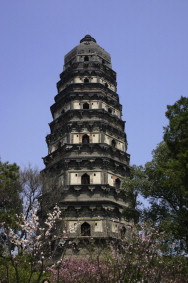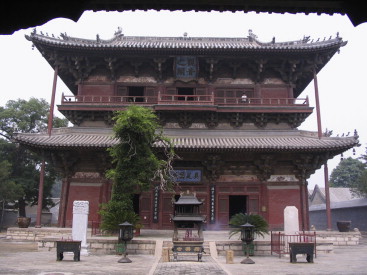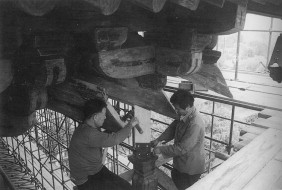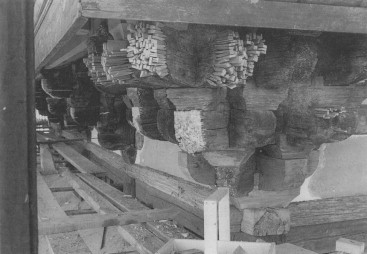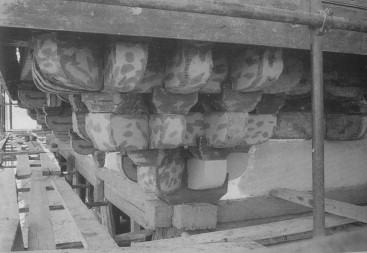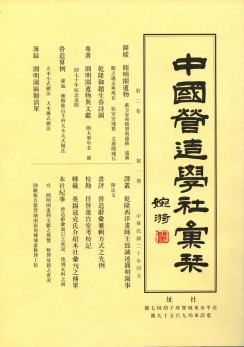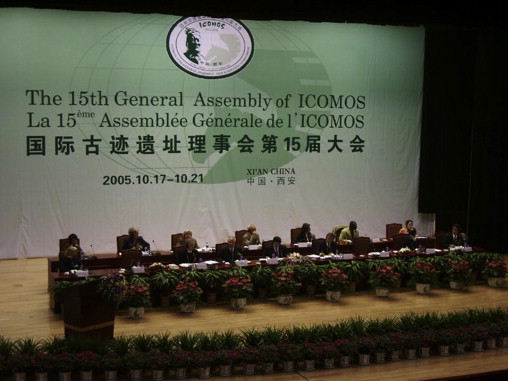Abstract
Chinas civilization is ancient. The countrys architectural heritage conservation activity is an integral part of the world conservation movement. This paper gives a general introduction of the movement in China from four aspects: (1) history; (2) important conservation projects assessments; (3) new ideas and principles being debated and discussed; and (4) issues facing the movement. The present paper summarizes the essential character of the movement in China and highlights the importance of supporting and protecting this movement.
Keywords
Conservation ; Architectural heritage ; China ; Character ; Principle ; Debate
1. Introduction
In China, the movement for the conservation of Chinese cultural heritage is a holistic movement. This movement seeks the protection of all aspects of Chinese cultural heritage, because such heritage cannot exist nor be understood except in relation to the interdependent parts comprising it.
Chinas architectural heritage, one aspect of the countrys cultural heritage, relies on the understanding of its various interdependent factors.
2. History
2.1. Present status
At present, China is not only an ancient civilization that is rich in cultural heritage resources, but is also a nation with strong initiatives in cultural heritage conservation. In 1987, China joined the World Heritage Organization (WHO). In 1989, of all of Chinas potential cultural and natural heritage locations, WHO approved six as world heritage sites. By 2006, 2351 and 3000 heritage artifacts were approved as national and provincial heritage items, respectively. By 2010, more than 110 towns were approved to be national grade and were awarded the title “Historically and Culturally Famous City”. By 2011, China has come to hold the third largest number of world heritage awards, a total of 42 (Annual Report on the Development of Chinas Cultural Heritage Management System, 2008 ). This fact is unsurprising because China is one of the worlds few ancient civilizations that was never destroyed and has thrived from as early as 2000 B.C. up to the present. Moreover, with the addition of a seventh group of national grade heritage artifacts, the total number of Chinese heritage items will reach at least 3000 (Fig. 1 ).
|
|
|
Fig. 1. Map showing the number of Chinas heritage items by province. |
2.2. Origins
The foundation of todays Chinese conservation system goes back a long way. The system is strongly associated with the influx of European culture into Asia, but is still of typical oriental character. The Chinese conservation system dates back to the beginning of the 20th century, but its cultural background began earlier, in the 17th and 18th centuries, when the academic criticism of historical texts characterized the emerging, new school of research. This new school of research was skeptical of historical documents, emphasizing textual criticism and analysis. Thus, intellectuals were motivated to study historic documents and relics.
In 1919, former premier Zhu Qiqian (Fig. 2 ) re-published a 13th century book, The Construction Methods of Building (Ying Zao Fa Shi), which he had chanced upon in a library in Nanjing the year before. This event initiated a movement of research into the history of building methods and systems.
|
|
|
Fig. 2. Mr. Zhu Qiqian (1872–1964). |
European natural science,—including mathematics, the calendar, and astronomy, was first introduced by missionaries and has also influenced academic thinking in China. Finally, the defeat at the Opium War in the mid-19th century has also abruptly changed the focus of Chinese intellectuals. Western knowledge and scientific systems were introduced into the country, initially through technology, then in scientific disciplines, and finally, through the humanities. Students who studied abroad brought back and organized academic disciplines and practical activities. These newly introduced undertakings included archeology and architectural heritage conservation.
The year 1929 was considered a landmark year. This year marked the establishment of the Society for Research in Chinese Architecture (hereinafter, the Society) in Beijing by Mr. Zhu Qiqian, who was the former Minister of Public Works and Deputy Premier of the former government. Through this society, document research activities began and were participated in by numerous officials and scholars.
Zhu Qiqian knew then that both contemporary architectural and archeological knowledge and traditional craftsmanship were important to society, having participated in the conservation efforts at the Forbidden City from 1910 to 1920, as well as in other conservation activities in Beijing. He invited two young professors, Prof. Liang Sicheng and Prof. Liu Dunzhen (Fig. 3 ; Fig. 4 ), to be Deputy Directors of the Societys two sections. He also established the research principles to direct future work.
|
|
|
Fig. 3. Mr. Liang Sicheng (1901–1972). |
|
|
|
Fig. 4. Mr. Liu Dunzhen (1897–1968). |
Zhu Qiqians inaugural address showed that the conservation movement in China was not starting from scratch. He summarized the experiences of the past decades and set an important direction for future research by suggesting four approaches.
First, Zhu said that research should be systematic and scientific. Second, he argued that research methods characterized by the separation of metaphysical and substantial aspects, as well as those that valued the knowledge of exegetics more than ancient ceremonial systems and intellectuals above craftsmen, should be changed. Rather, wisdom is to be gained through communication between intellectuals and craftsmen. Third, the Chinese name of the Society, “
”, did not contain the term “
”, architecture. This was deliberately done because despite the fact that Chinese architecture is the Societys chief concern, it was feared that this focus would restrict the scope of the Societys work. The Society also planned to investigate related fields, such as material arts, painting, and sculpture, as these subjects are used in decoration, silk, lacquer, metal work, and earthen ware, among others. When necessary, Zhu argued that having a broader scope will help the Society in explaining central problems and intangible culture, including traditions, beliefs, rituals, music, and dance.
Fourth, Zhu said that the further progress of the Society made members feel that the study of Chinese architecture is not the Societys private domain. The countrys eastern neighbors have helped in the preservation of old genres, with their tireless research along the same lines as that of the Chinese. Western friends have helped by offering the scientific method and their discoveries within this field.
Zhu viewed cultural heritage as being the integration of tangible and intangible heritage and the integration of Eastern and Western heritage. He considered cultural heritage as something that is open to interpretations and/or discoveries. Present conservation work in China is still inspired by Zhus effective guidelines (Zhu, Qi qian, 1930 ).
2.3. Four periods
Since the foundation of the Society almost a century ago, the Chinese conservation movement has undergone four distinct periods. The period from 1929 to 1949 was an open, fundamental, and exploratory period, but turbulent era for most of China because the country was beset by wars. These wars included the civil war and the Second World War. From 1929 to 1937, the achievements of the Chinese pioneers of the conservation movement were substantial. During this period, the Society was founded, and its plans were established. The plans included investigation and research, actual and urgent conservation projects, publishing, as well as legislation comprising local laws and bylaws on conservation. Non-governmental organizations (NGOs) played a major role during this period. Academic and financial supports were also received from abroad.
The practical period lasted from 1950 to 1978. Since 1950, following the establishment of the new republic, construction spread across China at a large scale. In 1961, for the protection of its cultural heritage, the central government introduced a national law that required the compiling of lists of heritage items, both at the national and provincial levels. This event was followed by projects, such as that in the Yangshao archeological site conservation in Xian, the replacement of the Yong Le Palace in Ruicheng, Shanxi province, and the restoration of Zhaozhou Bridge, in Zhao County, Hebei province.
From 1966 to 1976, during the Cultural Revolution, traditional culture was denounced throughout mainland China. A great number of cultural relics were destroyed by the general public. However, most of the listed national heritage sites were saved because these sites were under government control and were inaccessible to the public. This period was “closed” with regard to the conservation movement because most conservation activities were conducted by the government. Ideas of former Chinese scholars and the original technology of craftsmen were pursued. The opportunity to learn from abroad was precluded while the international conservation movement was progressing and creating documents summarizing recent conservation experiences.
The open-communication period lasted from 1979 to 1999. The Cultural Revolution ended in 1978, when the leaders of the Chinese Communist Party reversed the wrong policies of the past and decided to open and develop the country towards a new direction. As construction resumed, the enthusiasm for ancient culture also intensified.
The resumption of construction pushed urbanism from 20% in 1978 to 40% in 2001, consequently destroying numerous districts in old towns and several heritage buildings that were yet to be officially protected. Thus, intensifying enthusiasm stimulated people to pour their energy into studying and protecting their traditional heritage.
A battle for balance ensued in 1985, resulting in the proposal of a new concept for city heritage conservation, that is, the “historically and culturally famous city”. A total of 24 cities, including Beijing, Shanghai, and Suzhou, comprised the initial group announced by the central government.
When real estate entered the market economy, the fight between the two powers of construction and conservation intensified, thereby presenting both challenges and opportunities to the Chinese conservation movement.
The opportunity to learn from international academics emerged from Chinas “open” policy. After participating in the 1985 International Council on Monuments and Sites (ICOMOS) Conference, China declared, in the same year, the countrys acceptance of the international principles for heritage conservation.
Exchange and communication between Chinese and foreign colleagues significantly increased. Scholars returning from studying abroad in the 1990s have introduced new concepts, such as “authenticity”, “historical information”, and “minimal intervention”, surprising local Chinese scholars because these new concepts were substantially different from the Chinese experience, which emphasized the importance of restoration to the original state or the maintenance of the existing condition. This significant difference, along with the lack of Chinese case studies on the application of these new concepts, made the principles difficult to accept.
Since 1997, Chinas State Administration of Cultural Heritage has cooperated with the Australian ICOMOS and the Getty Conservation Institute, U.S.A. in preparing the Principles for the Conservation of Heritage Sites in China (Zhang, Bai, 2002 ) to address the new situation and to introduce China into the world arena. This document summarizes precious Chinese experiences from the past and incorporates such experiences into novel international academic achievements and advances. The Chinese language version of the document was published in 1999, whereas the English language version was published between 2001 and 2002.
The year 2000 up to the present marks a period of integration with multiple patterns. The publication of the Principles was a new landmark in the Chinese conservation movement, demonstrating Chinas respect for the international standards of value and respect for national and oriental cultural character and for practical experience. This document, along with Chinas applications for world heritage designations and achievements on important conservation projects in the mainland, illustrates a dramatic picture of the conservation movement in the 21st century.
2.4. Administration
Since the 1950s, Chinas conservation movement has primarily been administered by the government in terms of authority and budget. Nonetheless, various sectors of society exerted pressure on this movement.
Since the 1980s, such administration was handled by two governmental departments, namely, the Administration of Cultural Heritage for cultural world heritage and protected entities of various grades, which functioned based on the Law of Cultural Properties Protection, and the Ministry of Housing and Construction, for natural world and historic town heritage, which functioned under the Law of Urban and Suburban Planning and the Rules of Conservation of Historic Cities, Towns, and Villages. These two departments have different legislative foundations, but their administration is executed through local branches.
3. Conservation projects and assessments
3.1. Early 20th century
A notable non-traditional approach to conservation existed even before the founding of the Society for the Research in Chinese Architecture in 1929.
As an official of both the old and new governments assigned to lead and maintain the reformation projects of the capital city of Beijing, Mr. Zhu Qiqian, who knew traditional craftsmen, had to consider the new requirements of traffic and civil engineers. Thus, he studied new construction technology to be able to consider the use of new building materials.
When Chinese scholars in the 1920s used contemporary archeological methods to continue the excavation of the Yin dynasty ruins that were uncovered during the late 19th century at the village of Xiao Tun, Henan, where inscribed bones and tortoise shells had been found, that fact that one of the capitals of the Yin or the Shang Dynasty was proven to have been situated in this site. Thus, the site was called Yinxu. This Chinese civilization dated back to at least the Yin dynasty of 2000 B.C. Consequently, this finding had to be accepted by western academics.
Chinese intellectuals then came to believe that the contemporary scientific system was more efficient than the traditional approach. Thus, the use of concrete in conservation work was considered acceptable. This material was subsequently utilized in the restoration of the Bao Sheng Temple in Suzhou, and in Liang Si Chengs proposed restoration for the Lu He pagoda.
Similar to Europe, the fashionable view was that architecture was a type of art. This notion suggests that a buildings style, rather than the information it preserved, should be considered in its conservation.
3.2. Post 1950s
Conservation cases initially adopted a combination of methods, both new and traditional. Chinas first major project in the latter half of the 20th century was the conservation of the Zhao Zhou Bridge in Hebei province. This structure is considered the worlds largest and oldest stone-arched bridge, of the type known as “level arched” open spandrel built between 605 and 616 during the Sui Dynasty. This restoration case utilized reinforced concrete to strengthen the stone arches, while simultaneously using traditional methods to restore the balustrade in the pattern of the Sui dynasty. The restoration was performed by imitating the bridges original elements, which were retrieved from the river bed under the bridge (Fig. 5 , Fig. 6 ; Fig. 7 ).
|
|
|
Fig. 5. Zhaozhou Bridge before repair (photo by Luo Zhewen) (Shu et al., 2006 ). |
|
|
|
Fig. 6. Sixth-century balustrade of Zhaozhou Bridge found in a river bed. |
|
|
|
Fig. 7. The 24 Stone Arches of the Zhaozhou Bridge. |
In its recent restoration, the Nan Chachan Temple of the eighth century had some portions of its roof eaves demolished. These parts, which were rebuilt during the Qing dynasty (1670–1911), were not replaced because they not considered original and thus, were valuable at the time (Fig. 8 ).
|
|
|
Fig. 8. Eighth-century Nan Chan Temple conserved in the 1960s. |
Recently, however, the conservation approach has changed. At the Small Goose Pagoda in Xian, a crack resulted from an earthquake during the Ming dynasty in 1556. The crack was not repaired, but was left untouched during the conservation to protect the historical information it contained.
In the 1960s, plans were made to construct a reservoir in the middle of the Yellow River to produce electrical power. These plans required the relocation of the Daoist Yong Le Gong Temple, situated in the reservoirs flood plain, to a location 30 km away. The key technical issue for the central government was the unloading and replacement of the 14th century mural painted on the earth stucco surface of the adobe temple wall. To address this issue, Chinese engineers did not rely on any advanced technology, relying instead on a common method. The engineers decided to cut the finished wall into 2 m×2 m sections. The adobe was then peeled off from the stucco finish, and the mural/stucco pieces were unloaded onto a wood frame. The engineers then loaded the pieces onto a slow-driving lorry, finally reinstalling the pieces together at the new site. This experience gave Chinese conservators the confidence that traditional techniques can be excellent and inexpensive choices for conservation efforts. The solution depends on research into the key issue to determine the most suitable technology for the situation (Fig. 9 , Fig. 10 ; Fig. 11 ).
|
|
|
Fig. 9. Yong Le Gong before the mural was replaced (photo by Luo Zhewen) (Shu et al., 2006 ). |
|
|
|
Fig. 10. Yong Le Gong temple mural removal (photo by Luo Zhewen) (Shu et al., 2006 ). |
|
|
|
Fig. 11. Yong Le Gong temple mural removal (photo by Luo Zhewen) (Shu et al., 2006 ). |
In 1976, after the Tangshan earthquake, the government was presented with another technically difficult conservation case, for which a budget was provided. The Maiji Mountain Grottos in Gansu had been cut into the cliffs façade. Engineers and conservators have gathered in the site, continuously discussing the implementation of the proposed solutions for using concrete and anchor bars as reinforcements to hold the cracked rocks together, as well as to protect the remaining sections of the grottos. From this case, Chinese conservators discovered the advantage of inviting other advanced technical departments to assist them in solving major technical problems (Fig. 12 ).
|
|
|
Fig. 12. Grottos of Mai Ji Mountain (photo by Luo Zhewen) (Shu et al., 2006 ). |
In the 1980s, a similar case involving the conservation engineering of the 10th century Huqiu Pagoda at Suzhou, Jiangsu was presented (Fig. 13 ). The brick pagoda had a noticeable incline, and a large number of civil engineers and scholars of other related disciplines throughout China converged, cooperated, and completed the reinforcement of the Pagodas foundation to mitigate its tendency to incline.
|
|
|
Fig. 13. Hu Qiu Pagoda, the Chinese leaning pogoda, Suzhou. |
Although the documentation of the project may not have reached the highest level at that time, Chinese conservators were shown to insist on analyzing contradicting views and on finding suitable and practical working methods. This event was a top-level achievement for China at the time.
A typical case of excellent 1990s conservation was the Guan Yin Tower project in Du Le Temple, Ji County, Hebei. These efforts were initiated at the time China joined ICOMOS and was encountering issues with some international principles. Guan Yin Tower withstood numerous earthquakes, including the Tangshan earthquake in 1976, during which its wooden frame became unstable and its eaves began to sag. The disassembly method of conservation engineering was employed for these parts of the structure, which were to be repaired and then replaced, but most of the wood brackets were repaired in place (Fig. 14 , Fig. 15 , Fig. 16 , Fig. 17 ; Fig. 18 ).
|
|
|
Fig. 14. Restored Guan Yin Tower of Du Le Temple. |
|
|
|
Fig. 15. New portion being added to an existing pillar of the Guan Yin Tower. The addition was made to support sagging eaves while retaining the buildings historical information (photo taken from Yang, Xin, 2007 ). |
|
|
|
Fig. 16. Restoration of the Guan Yin Tower. The first step in repairing the weathered wood brackets involved the addition of small wood pieces into the weathered holes (photo taken from Yang, Xin, 2007 ). |
|
|
|
Fig. 17. Filling-up the gaps: the second process of repairing the brackets (photo taken from Yang, Xin, 2007 ). |
|
|
|
Fig. 18. Disassembly proposal for some elements of the Guan Yin Tower. |
Cases during the 1950s to the 1990s were characterized by carefully researched proposals, slow execution, and minimal budget. Likewise, conservators preferred traditional techniques, although new techniques were accepted when necessary. Chinese conservators were practical problem-solvers.
3.3. Legislation, publications, and scientific research
3.3.1. Legislation
The first national regulation for heritage conservation after the 1950s was the Administrative Regulation for the Conservation of Cultural Relics. Published by the central government in 1961, this law played an important role even during the Cultural Revolution.
As the first national law on heritage conservation preceded by a national law on city planning that was directed at the emerging construction boom, the Law of the Conservation of Cultural Properties was published in 1982, subsequently being amended several times in 1991, 2002, and 2008. The amendments were made to address the requirement for better legislation dealing with issues arising from the great scale of construction and urbanization occurring at that time.
Since 1991, as China finally opened its doors to connect with the international community, a series of relevant local laws, technical regulations, and codes were introduced.
Aside from the famous Principles (1999), which provided the working procedures for the countrys conservation activities, the most important documents on Chinas conservation programs are the Principles for the Conservation Planning of National Cultural Heritage and the Application for Approval for Conservation Planning of National Cultural Heritage. Both of these documents were set into law in 2004.
Since 2004, all construction and related activities at national heritage sites were mandated to follow a process of conservation, planning, and approval. These processes are primarily administrative measures which are effective controls aimed at the protection of heritage sites against excessive construction activities.
Although the movement for “historically and culturally famous cities” began in the 1980s, it was only in 2009 that relevant national legislation was published. This event occurred when the National Assembly of the Peoples' Delegation approved the Regulation for Historic Cities, Townships, and Villages. Shortly before this time, various local enactments were also passed, including regulations such as the Conservation Regulation for Historic Cities and Townships in Shanghai, Zhejiang, Jiangsu, and Shandong. A number of technical codes and guidelines, such as the Conservation Planning Code for Historic Towns (2005) and the Guideline for Conservation Planning for Historic Areas (2008) in Jiangsu Province were also established.
3.3.2. Publications
The publication of academic journals on architectural heritage started in 1929. The first of such publication, the Bulletin of the Society for Research in Chinese Architecture, was considered the best. Aside from being edited by top scholars, this journal was fully sponsored by Chinese and foreign organizations and individuals. However, when financial support for the journal ended, it stopped publication in 1946 (Fig. 19 ).
|
|
|
Fig. 19. Front cover of the Bulletin for Research in Chinese Architecture (1930). |
In the 1950s, information on conservation activities was published in a minor bulletin, the Reference for Cultural Relics, which subsequently became a popular, nationally recognized journal called Cultural Relics. This bulletin focused on cultural heritage research and conservation.
After the hiatus of the Cultural Revolution, especially during the present century, a group of wide-ranging publications emerged. At the national, local, and university levels, these journals, including the Journal of Architecture and the Journal of Planners, discussed the subject of architectural heritage conservation.
Since 2004, the Information Center under the State Administration of Cultural Heritage has been publishing a journal focusing on conservation engineering. Although highly valued and subscription-based, this journal is still awaiting “permission”. The journal is yet to be given a publishing number from the State News and Publishing Agency, as required by Chinese law.
3.3.3. Scientific research
In light of the increase in the state budget for conservation from several millions to several billions of Yuan, the State Administration for Cultural Heritage has been organizing a series of scientific activities since the 1990s.
At the national level, the National Academy of Heritage Conservation Research, headed by a Director of the Academy, is the new institution under the Research Institute of Cultural Relics.
At the provincial level, research bases on various individual disciplines have been established at research institutes, museums, and universities. Research projects have been awarded to these bases through invited tenders.
Every year, the Ministry of Science and Technology and the National Natural Science Foundation, which is responsible for national scientific research, work with their local departments to devised valuable research projects for the conservation movement. These organizations, along with other ministries, have organized various conferences, such as the following: “Existing Building Conservation Technology (2009)” at Tongji University, “Application of Spacial Information Technology in the Conservation of Historic Sites of Great Scale (2008)” at Qinghua University, and “Adaptable Technology for Urban Heritage Conservation (2011)” at Southeast University, Nanjing.
These research projects and their laboratories were supported by the State Administration of Cultural Heritage and the Ministry of Housing and Construction.
3.4. Post ICOMOS conservation movement developments
Since China joined ICOMOS in 1985, the countrys improved financial situation has resulted in significant and important changes and developments to the conservation movement. Government leaders, aiming for political gain, have supported the conservation movement as the countrys social position stabilized. As a result, several international conferences have been held in Xian, Suzhou, and Beijing (Fig. 20 ).
|
|
|
Fig. 20. 15th General Assembly of ICOMOS in Xian (2005). |
International conservation principles and concepts have been introduced throughout the country. Attempts have been made to apply these concepts, which should prove to be very effective in the future. The scope of conservation has followed the international tendency and embraced new categories of heritage, including the vernacular, industrial, and cultural landscapes, which have never been considered previously.
In the developed areas of East China, the model of conservation has evolved from being rough to being careful. In other words, the process of conservation has become “scientific”.
In all of Chinas conservation activities, conservation planning has been established as the first step. Many different levels of conservation planning have been developed, from the national heritage to the world heritage administration levels. This development extends over several provinces and even countries.
4. Characteristics of conservation
In the 20th century, the encounter between the international concepts of conservation and the Chinese experience, which was based on centuries of practice, produced an eruption of arguments on their differences. Some scholars argued that the unsynchronous historical development of China and Europe resulted in distinct disparities. Nonetheless, such a situation has resulted in the initiative to improve Chinas developing economy and has globalized the countrys social culture.
4.1. Traditional thought
The Chinese cultural character, distinct from that of Europeans', was significantly influenced by the ideas of Chinas great thinker, Confucius (551–479 B.C.). Epitomizing ancient Chinese civilization, this great scholars ideas infused tradition, even influencing the Chinese conservation movement.
Among other principles, Confucius emphasized the importance of daily life, saying “How can you understand death if you don't understand life?” and “Respect spirits, but avoid meeting them” (Confucius. Analects (
).
Confucius opined that respect for ancestors must be shown by planting a tree over the ancestors grave to mark its location and by remembering the worship ceremony. This principle specifically indicates that Confucius was against complicated and extravagant ceremonies.
He also emphasized spiritual heritage in his summary of the ancient ceremonial system, saying “Offer sacrifice to the god as if the god lives”, which means that people should respect the gods by a clean spirit, not by superstition.
In Chinese tradition, the system itself is still more important than the substantial heritage.
During the Song dynasty (960–1279 A.D.), a Confucian scholar named Zhu Xi, continued Confuciuss idea when he discussed the ceremonial system of the emperors ancestors' temples. He commented on the arrangement of the constantly accumulating number of dead emperors worship tablets, saying that “The fifth generation ancestors tablet should be moved out of the main hall into another of the temples halls”.
He argued that only five emperors tablets should be placed in the main hall at any given time, those of the dynastys first four emperors and that of the most recently deceased emperor.
Space and cost could be saved without retaining the ancestors substantial heritage forever.
Ancient Chinese thinkers have separated heritage into the tangible Ware (
, Qi) and the intangible TAO (
). Seeking to highlight the intangible TAO, Laozi (6th Century B.C.) stated, “Hence, the being (substance) provides a condition under which usefulness is found, but the nothingness (space) is the usefulness itself” (Lao, Tzu,1997 ). This idea likely has to do with the thought on life and death.
The famous Han dynasty (206 B.C.–220 A.D.) historian Sima Qian also believed that ones life comes from the spirit. He said that “Spirit is the root of life; and the form of the body its shelter” (Sima, Qian. Records of the Historian ). This principle means that the spirit continues to live on after death, which was a widespread belief during ancient times. Thus, the fact that the 16th Assembly of ICOMOS, 2008, in Quebec, took the idea of Spirit of Place China as its theme appropriately indicated the Assemblys profound understanding of this concept.
4.2. Eastern practice meets western concepts
As international conservation concepts were introduced into China, especially when the document on the Principles was first published, the concepts and their application were increasingly discussed and critically debated. Only after four years of thorough editing did the Principles' role was tested in practice.
In 2005, senior scholars and engineers gathered in the hometown of Confucius, Qufu, Shangdon, and approved a momentous document known as the Qufu Declaration. This document expressed their disagreement with certain conservation methods arising from the new concepts. They based their views on their actual restoration experience at the Forbidden City, including experiences from other cases dating back to the late Qing dynasty until the 1990s.
Their perspective encompassed four fields of debate.
4.3. Authenticity
The concept of authenticity dates back to the Venice Charter of 1964, which mentioned the role of monuments as historic evidence. This matter has been discussed constantly in the last 20 years, such as in the Nara Document on Authenticity and in the Declaration of San Antonio.
The basic idea of authenticity, that is, that historical information is carried by the entire structural remains of different times, has been reflected in the Principles. The Principles states that “The esthetic value of a site derives from its historic authenticity. Alterations to the historic condition may not be made for cosmetic purposes or to attain completeness” (Article 3, 1964 ). The Principles also mandates that “Heritage sites must be historically authentic”.
Furthermore, the Principles states that “Physical remains must be in their historic condition. This includes a sites condition as it was originally created, its condition after undergoing repeated adaptation throughout history, and its condition as a result of deterioration or damage over a long period”.
However, the Qufu Declaration, in its case study, showed that at least some architectural information was carried by the timber structural system itself, indicating that accumulated information gathered from different times would not be more important than those from a particular period. Thus, while retaining part of the original building and/or structure is important, the other parts may be repaired and/or replaced as necessary.
China may need to guard against the demand for very thorough or strict authenticity, a demand that is extremely difficult to meet in rural communities.
4.4. Replacement or reconstruction
The Venice Charter emphasized that, when the existing position of a structure cannot be retained, “… any new work which is indispensable must be distinct from the architectural composition and must bear a contemporary character. The restoration, in any case, must be preceded and followed by an archeological and historical study of the monument”.
The Principles, having summarized the Chinese experience, is rather more flexible, allowing that, “When restoring a site to a safe and stable historic condition, it is permitted to repair or to add a minimum of new fabric, though it is not permitted to replace old fabric or to add large quantities of new fabric”. The articles on reconstruction contained in the Principles have also been incorporated in the Law on the Protection of Cultural Property, revised in 2002.
Article 22 states that “When the cultural property has been damaged totally, protection of the site should be implemented, rebuilding is not to be allowed in situ, except on a very particular condition and if it gets permission from the State Administration of Cultural heritage and approval by the provincial government (for provincial heritage) or by the central government (for national heritage).”
According to Article 25 “A building that no longer survives should not be reconstructed. Only in specially approved cases may a select few such former buildings be reconstructed in situ. This may occur only where there exists definite evidence that has been confirmed by experts. Reconstruction may only be undertaken after the approval process has been completed in compliance with the law and permission has been granted. Reconstructed buildings should be clearly marked as such.”
Article 33 reads “Reconstruction in situ is an exceptional measure undertaken only in special circumstances. When approval has been given to undertake reconstruction in situ, priority should be given to conserving the remaining ruins without damaging them in the process. Reconstruction must be based on direct evidence. Conjectural reconstruction is not permitted.”
The Qufu Declaration, however, considered this matter differently. The declaration states that replacement and reconstruction should be a normal measure, not an occasional or exceptional approach:
“Based on the timber structure, Chinese traditional architecture … has its own material, technique and regularity of decay. In dealing with heritage building, if we use the original construction pattern, original material, original approach and original technique … our reconstruction will keep its scientific, artistic and heritage value … If we have enough budget and muster enough evidence of the original fabric, we must repair it scientifically—reconstruct it to its original healthy condition … The value of cultural heritage depends on its existing … if we lose the heritage, we'll lose the value …”.
4.5. Disassembly
Disassembly and reassembly is the traditional method for conserving wooden buildings.
In the Qufu Declaration, scholars marked the importance of this process “Disassembly is an important method of traditional conservation which can effectively and thoroughly cure the illness of a structure and prolong its life. If there is serious illness in the whole structure or in a key part, we should use the disassembly method—when other methods do not work.”
However, the Principles and its commentary prescribe minimal intervention “Major restoration through complete disassembly of a structure should be avoided as far as possible; instead, other types of intervention should be used to make the entire structure stable and safe.”
Both sides of the debate are reasonable, and both traditional and contemporary methods are useful depending on the cases at hand. Such an instance was found in the concrete painting at the Dule Temple, Hebei, where disassembly was used for a portion of the eaves elements, while work on the other parts complied with the Principles and with other contemporary ideas.
4.6. Color-painting controversy
The collection of international documents on heritage conservation comprises countless cases and problems, all of which were analyzed, generalized, and summarized, and with each document having its own focus. Presently, most Chinese scholars are unfamiliar with these documents.
The international principles are not based solely on the experience of any single nation. Instead, these principles are founded on the collective wisdom of many nations with more than hundreds of years of experience. Although the European experience basically includes both masonry and timber structures, the different heritage conservation approaches of the West and the East cannot be explained by structural differences alone.
Applying the principles is more complicated than merely quoting them because not all those who talk about the international principles are masters of the practical conservation experience. Likewise, although differences between cultural backgrounds must be discussed, the analysis of real cases must be the basis for significant debate.
A relevant situation, a color painting controversy, occurred when the Imperial and Summer Palaces in Beijing were undergoing “color-painting conservation.” Western scholars criticized the conservation method being used because some old and decayed color paintings on the wood elements were removed and replaced. The criticism emerged because the method used by the Chinese was relatively different from the approach used for European wall paintings. The debates resulted in a resolution in the 30th Session of the World Heritage Committee that was held at Vilnius, Lithuania, in 2006, reflecting some concerns and doubts on the Chinese conservation proposal. The meeting resulted in a decision requesting China to hold an international meeting to discuss this conservation issue.
In May 2007, the resulting International Symposium on the Concepts and Practices of Conservation of Historic Buildings in East Asia was held in Beijing. This symposium was jointly organized by the China State Administration of Cultural Heritage and the International Center for the Study of the Preservation and Restoration of Cultural Property, the ICOMOS, and the United Nations Educational, Scientific, and Cultural Organizations World Heritage Center.
Representatives of various international organizations from 26 countries participated in this symposium. The meeting was held to primarily address the concerns and suggestions raised earlier at Vilnius over the current restoration work at the Imperial and Summer Palaces and the Temple of Heaven in Beijing. The symposium also conducted follow-up debates on the implementation of the principles and practices for the preservation of heritage to reflect different cultures and traditions.
The on-site investigations and discussions during the symposium opened the eyes of many. For instance, the color painting on the wooden surfaces of the structures of East Asia was noticed to provide not only decoration, but also protection.
The richness of such surfaces, which was exhibited by the variety of cultural expression, esthetic achievement, and diversity of materials, often unchanged for centuries and reflected in the work of the master craftsmen, is an essential component of the visible part of monuments. Such surfaces, which form the protective layers of historic buildings, are best cared for through regular maintenance because they are subject to weathering and wear and tear and often require repair.
Among other concepts, the meeting emphasized the universal value of the international principles that guarantee that Chinese conservation practices are the proper way to best preserve important historic information.
5. Issues
In the past three decades, Chinas rapid development has thrust the country into the position of being the second largest economic entity in the world, giving the false impression that China has become a rich country. However, although the Chinese GDP in 2010 ranked second in the world, the reality is that the GDP per person was below 100. A growing gap in economic levels exists between the rural areas of West China and the urban areas of East China. Most parts of the country, especially the rural areas of Middle and West China, remain poor. This situation is unlike in large Eastern cities, such as Shanghai, Beijing, and Guangzhou.
Only public international affairs, such as the Olympic Games, as well as national and a number of important local projects, truly benefit from the support and funding of the central government. As a result, conservation efforts at the local level are faced with daunting issues.
In West and Middle China, the lack of financial support from either the central or provincial governments for conservation projects prevents compliance with the working procedures prescribed in the Principles. This situation also inhibits motivation for cultural heritage protection in provinces and cities.
In the conservation of vernacular architecture among old rural villages, farmers are unable to comply with the prescribed procedures because of the lack of access to sufficient budget. They cannot meet the standards for the protection of a heritage entity under the Principles, which requires minimal changes to any structure. The farmers must be able to satisfy all the requirements under the Principles, which they must continue using in the initiatives to improve their buildings.
Other heritage sites, such as industrial, canal, and certain cultural landscapes, also face similar problems in meeting technical standards. Most local entities are unable to comply with the Law of Cultural Property, which requires that no changes should be made to a propertys existing appearance.
The leader of the State Administration of Cultural Heritage has called for a change in policy for the conservation of cultural relics. This official is pushing for a more inclusive conservation of cultural heritage, although the relevant legislation has yet to be ratified. Nonetheless, the passing of this law is an important objective for the next period in relation to Chinas 12th Five Year Plan.
A very important and active element in Chinas conservation movement, that is, all the people involved, has currently become a bottleneck restricting the movements development. The conservation program is currently beset by a shortage of craftsmen and NGO personnel.
Compared with developed countries, Chinas critical shortage of NGOs leaves the movements social foundation in a fragile state. Whenever the result of a government decision is objectionable, such situations cannot be rectified promptly because nobody is available to voice their opposition.
The solution to this problem rests upon the plans for social development and public administration set out in the governments 12th Five Year Plan from 2011 to 2015.
6. Conclusion
The Chinese economy is continuously developing, and per-person income is gradually increasing as China becomes globalized. Likewise, the differences in conservation methods between China and the West are also being modified.
China hopes to provide an example of how a country can integrate its numerous varying parts, showing how the world may become more unified. China aims to achieve this objective through its traditional, holistic approach to life, particularly its holistic approach to cultural conservation.
Chinas conservation movement will maintain its constant communication with other conservators around the world, realizing that the awareness of individual richness will enable the world to derive more from the deep and uniquely different cultural backgrounds of all individual countries.
Through interdependence with all conservation programs throughout the world, Chinas architectural heritage conservation movement is striving to conserve that of the entire world to keep each individual mindful of the Earths magnificence.
References
- Annual Report on the Development of Chinas Cultural Heritage Management System, 2008 Annual Report on the Development of Chinas Cultural Heritage Management System, 2008. Social. Science Academic Press.
- Article 3, Article 3, 1964. Venice Charter.
- Confucius, Confucius. Analects ( ).
- Tzu, 1997 Lao, Tzu, 1997. Tao Te Ching ( ). Translated by Arthur Waley. Published by Wordsworth Editions Limited.
- Yi and Zhu Zhu, 2006 Shu, Yi, Yao, Zhu Zhu, 2006. Luo Zhe Wen and His Seventy Years Works ( ). Chinese Culture and History Press.
- Qian, Sima, Qian. Authors preface. Records of the Historian ( ), vol. 130, pp. 358.
- Yang, 2007 Yang, Xin, 2007. Du Le Temple of Ji County ( ), Cultural Heritage Press.
- Bai, 2002 Zhang, Bai, 2002. On the development of the principles for the conservation of heritage site in China. The Book Principles for the Conservation of Heritage Sites in China, issued by China ICOMOS, pp. 91.
- Qi qian, 1930 Zhu, Qi qian, 1930. Reason of Organization of Society for Research in Chinese Architecture ( ). The Bulletin of the Society for the Research in Chinese Architecture, no. 1, vol. 1, pp. 1 (July).
Document information
Published on 12/05/17
Submitted on 12/05/17
Licence: Other
Share this document
Keywords
claim authorship
Are you one of the authors of this document?
